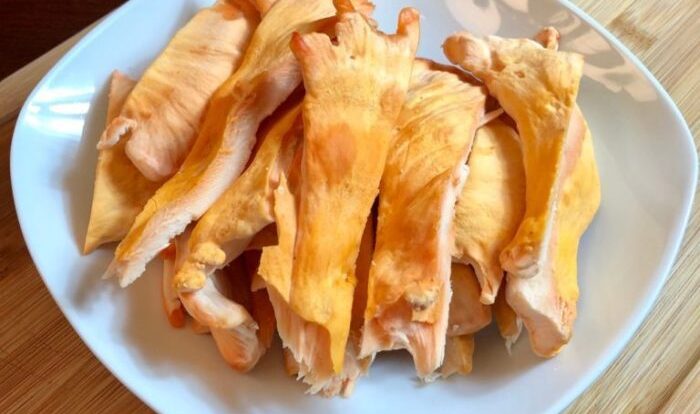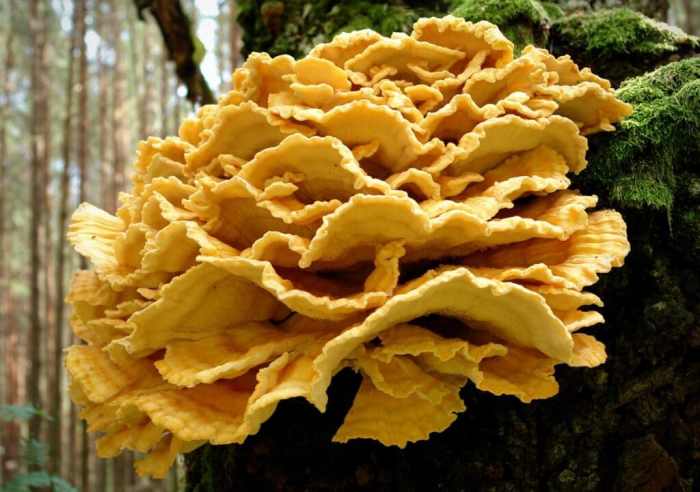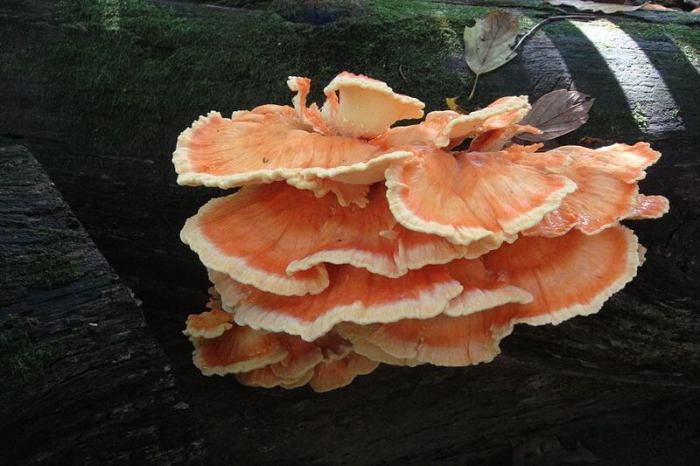
Discover the culinary wonders of the chicken of the woods recipe, a vibrant and flavorful mushroom that transforms ordinary dishes into extraordinary feasts. From traditional cooking methods to modern culinary innovations, this guide will lead you on a journey through the diverse flavors and health benefits of this forest delicacy.
Whether you’re a seasoned forager or a curious home cook, this recipe will inspire you to create dishes that tantalize your taste buds and nourish your body. Let’s dive into the world of chicken of the woods and explore its culinary potential!
Recipe Variations

Chicken of the woods is a versatile mushroom that can be cooked in a variety of ways. From traditional sautéing to modern grilling and international roasting, the cooking method you choose will impact the flavor and texture of the dish.
Traditional Methods
- Sautéing:Sautéing chicken of the woods in butter or oil is a classic way to cook it. This method brings out the mushroom’s earthy flavor and gives it a slightly crispy texture.
- Grilling:Grilling chicken of the woods over medium heat is another popular option. This method gives the mushroom a smoky flavor and a slightly chewy texture.
- Roasting:Roasting chicken of the woods in the oven is a great way to caramelize its natural sugars and bring out its sweetness. This method gives the mushroom a tender and juicy texture.
Modern Techniques
- Sous Vide:Cooking chicken of the woods sous vide is a modern technique that results in a tender and flavorful mushroom. This method involves sealing the mushroom in a vacuum-sealed bag and cooking it in a water bath at a precise temperature.
- Air Frying:Air frying chicken of the woods is a quick and easy way to cook it. This method gives the mushroom a crispy texture and a slightly smoky flavor.
International Cuisines, Chicken of the woods recipe
- Italian:In Italian cuisine, chicken of the woods is often used in pasta dishes and risottos. It can also be sautéed and served with polenta.
- French:In French cuisine, chicken of the woods is often used in soups and stews. It can also be sautéed and served with a creamy sauce.
- Chinese:In Chinese cuisine, chicken of the woods is often used in stir-fries and soups. It can also be braised or roasted.
Flavor Profiles and Pairings
Chicken of the woods possesses a unique and delectable flavor profile that sets it apart from other mushrooms. Its meaty texture and savory umami notes make it an excellent substitute for chicken in various dishes. The flavor of chicken of the woods is often described as having a slightly nutty, earthy, and slightly sweet taste.
To enhance the inherent flavors of chicken of the woods, consider incorporating complementary ingredients and seasonings. Herbs like thyme, rosemary, and sage pair well with the mushroom’s earthy notes. Garlic and onions add a savory depth, while a touch of lemon juice or white wine can brighten the flavor profile.
If you’re looking for a unique and flavorful dish, look no further than the chicken of the woods recipe . This edible mushroom has a meaty texture and a slightly sweet taste that pairs perfectly with a variety of sauces and seasonings.
Additionally, marinating chicken of the woods in a mixture of olive oil, herbs, and spices before cooking can further intensify its flavors.
Cooking Techniques and Flavor Alterations
The cooking technique you choose can significantly influence the flavor characteristics of chicken of the woods. Pan-frying or grilling the mushrooms over high heat creates a crispy exterior and caramelizes the natural sugars, resulting in a rich and flavorful experience.
Conversely, sautéing or stewing chicken of the woods in a flavorful liquid, such as a broth or sauce, allows the mushrooms to absorb the surrounding flavors and become more tender.
Beverage Pairings
Chicken of the woods pairs exceptionally well with a variety of beverages. Full-bodied red wines, such as Cabernet Sauvignon or Merlot, complement the mushroom’s earthy flavors. For a lighter option, consider pairing chicken of the woods with a crisp white wine like Sauvignon Blanc or Pinot Grigio.
Craft beers, particularly those with nutty or earthy notes, can also be a delightful accompaniment to this versatile mushroom.
Chicken of the woods is a type of edible mushroom that can be found in forests all over the world. It’s known for its bright orange color and its meaty texture. If you’re looking for a delicious and easy way to cook chicken of the woods, check out this chicken of the woods recipe .
Nutritional Value and Health Benefits

Chicken of the woods is a nutritional powerhouse, boasting a rich composition of essential nutrients. It is an excellent source of protein, providing all the essential amino acids required for optimal bodily function.
In addition to its protein content, chicken of the woods is also a good source of dietary fiber, which is crucial for maintaining a healthy digestive system and promoting satiety. Moreover, it is packed with vitamins, including vitamin D, which is vital for bone health, and B vitamins, which play a key role in energy metabolism and nerve function.
Antioxidant Properties
Chicken of the woods contains a wide range of antioxidants, which are compounds that protect cells from damage caused by free radicals. These antioxidants have been linked to numerous health benefits, including reduced inflammation, improved immune function, and a lower risk of chronic diseases such as cancer and heart disease.
Immune System Support
Chicken of the woods is believed to have immune-boosting properties due to the presence of polysaccharides, which are complex carbohydrates that have been shown to stimulate the immune system. Additionally, it contains compounds that have antimicrobial and antiviral activities, further supporting its role in immune health.
Maximizing Nutrient Retention
To maximize nutrient retention during cooking, it is recommended to use gentle cooking methods such as sautéing, grilling, or roasting at low temperatures. Avoid overcooking, as this can lead to nutrient loss. Additionally, it is best to consume chicken of the woods fresh or within a few days of harvesting to preserve its nutritional value.
Foraging and Identification

Chicken of the woods, a versatile and delectable edible mushroom, can be found in diverse habitats. Identifying and foraging for this mushroom requires careful observation and responsible practices.
Chicken of the woods typically flourishes in moist, shaded areas, particularly near the base of oak trees or on decaying oak logs. Its growing season extends from late spring to early fall, with optimal conditions during warm and humid weather.
Key Characteristics
- Color:Bright orange to golden yellow, fading to pale yellow or white with age.
- Shape:Irregular, shelf-like or fan-shaped, with a wavy or lobed margin.
- Size:Can range from a few inches to over a foot in diameter.
- Texture:Firm and meaty when young, becoming softer and more tender with maturity.
- Odor:Mild, slightly fruity or nutty.
Responsible Foraging
When foraging for chicken of the woods, it’s crucial to practice responsible harvesting techniques. Only collect mushrooms that are in good condition and avoid overharvesting from a single location. Leave behind some mushrooms to ensure the sustainability of the population.
Culinary Applications and Presentation

Chicken of the woods is a versatile culinary delight that can be incorporated into a wide range of dishes, from soups and stews to salads and pasta. Its unique texture and flavor make it an excellent substitute for chicken or other meats.
When presenting chicken of the woods dishes, consider the aesthetic appeal. Arrange the chicken in an eye-catching manner on a serving platter or in individual bowls. Garnish with fresh herbs, such as thyme or rosemary, or a drizzle of olive oil and a sprinkle of sea salt.
Incorporating Chicken of the Woods into Various Dishes
- Soups and Stews:Add diced chicken of the woods to soups and stews for a hearty and flavorful boost. It pairs well with root vegetables, such as carrots and potatoes, and can be simmered in a flavorful broth.
- Salads:Shredded or sliced chicken of the woods adds a unique texture and flavor to salads. Combine it with mixed greens, vegetables, and a tangy vinaigrette.
- Pasta Dishes:Sautéed chicken of the woods can be tossed with pasta, vegetables, and a creamy or tomato-based sauce for a satisfying and flavorful meal.
Garnishes, Sauces, and Accompaniments
Enhance the dining experience by incorporating garnishes, sauces, and accompaniments that complement the flavor and texture of chicken of the woods.
- Garnishes:Fresh herbs, such as thyme, rosemary, or parsley, add a touch of freshness and color to chicken of the woods dishes.
- Sauces:A creamy mushroom sauce, a tangy vinaigrette, or a flavorful marinade can enhance the flavor of chicken of the woods.
- Accompaniments:Serve chicken of the woods with crusty bread, mashed potatoes, or roasted vegetables to complete the meal.
Final Review: Chicken Of The Woods Recipe

As we conclude our culinary adventure, remember that chicken of the woods is not just a mushroom; it’s a versatile ingredient that can elevate any dish. Whether you’re sautéing, grilling, or roasting, the unique flavor profile of chicken of the woods will leave a lasting impression on your palate.
So, embrace the flavors of the forest and incorporate this culinary gem into your next meal. Experiment with different recipes, savor the health benefits, and share the joy of chicken of the woods with your loved ones. Bon appétit!
FAQ Resource
Can I eat chicken of the woods raw?
No, it’s not recommended to consume chicken of the woods raw. Cooking helps release its full flavor and ensures it’s safe to eat.
What does chicken of the woods taste like?
Chicken of the woods has a unique flavor that resembles chicken or crab, with a slightly earthy and nutty undertone.
How can I store chicken of the woods?
Fresh chicken of the woods should be stored in a paper bag in the refrigerator for up to 3 days. You can also freeze it for longer storage.






